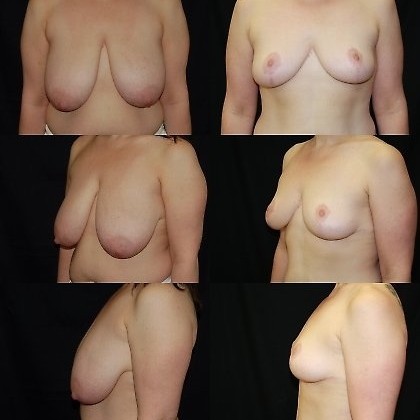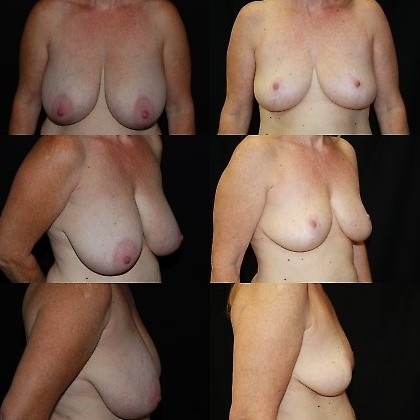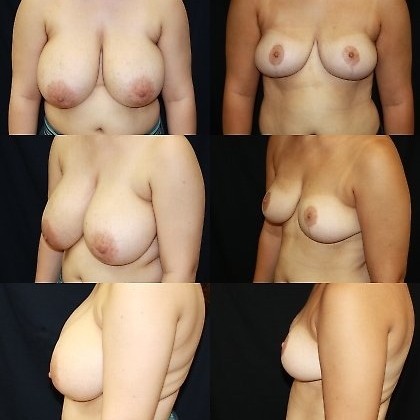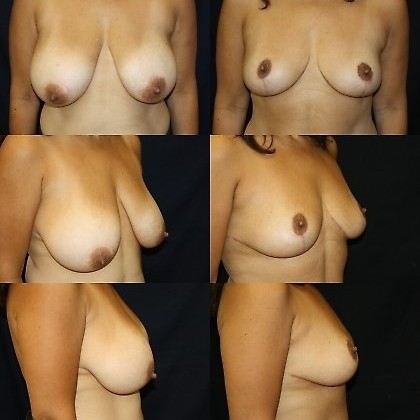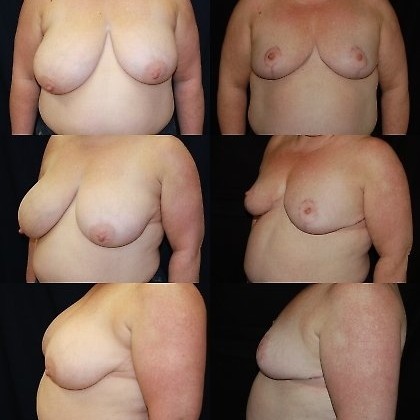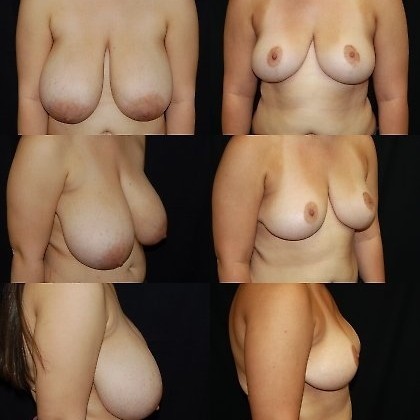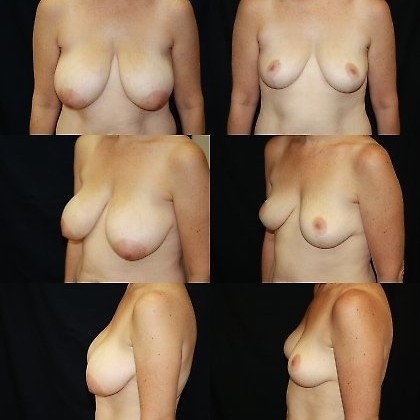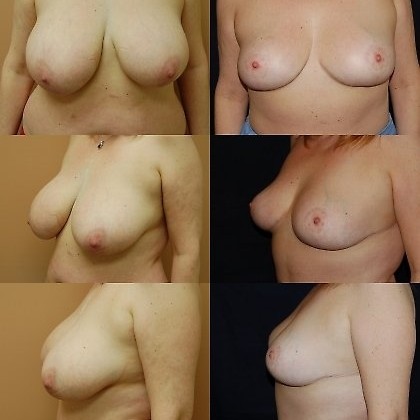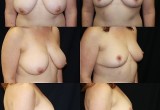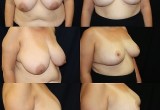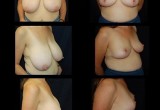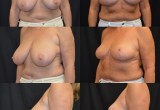Breast Reduction
Breast reduction, or reduction mammoplasty, is a procedure that removes fat, glandular tissue, and skin from the breasts, making them smaller, lighter, and more firm. It can also reduce the size of the areola, the darker skin surrounding the nipple. The goal is to produce smaller, better-shaped breasts in proportion with the rest of the body.If you are considering breast reduction, the following will give you a basic understanding of the procedure, when it can help, how it is performed, and what results you can expect. It cannot answer all of your questions, since much depends on your individual circumstances. Please be sure to ask Dr. Baroody any questions you may have about breast reduction surgery.
THE BEST CANDIDATES FOR BREAST REDUCTION
Breast reduction may be performed for either physical relief or cosmetic improvement. In most cases, breast reduction is not performed until a woman's breasts are fully developed; however, it may be done earlier if large breasts are causing significant emotional or physical discomfort. The best candidates are those who have realistic expectations about the results. Breast reduction is not recommended for women who intend to breast-feed. The best results are produced in those who are not over-weight or obese.
ALL SURGERY CARRIES SOME UNCERTAINTY AND RISK
A breast reduction is normally safe when performed by a board-certified plastic surgeon. Nevertheless, as with any surgery, there is always a possibility of complications or a reaction to anesthesia. Bleeding and infection following a breast reduction are uncommon, but they can cause scars to widen. You may reduce your risks by closely following Dr. Baroody's advice both before and after surgery. Breast reduction does leave noticeable, permanent scars, although they'll be covered by your bra or bathing suit. (Poor healing and wider scars are more common in smokers.) The procedure can also leave you with unevenly positioned nipples, or a permanent loss of feeling in your nipples or breasts. Rarely, the nipple and areola may lose their blood supply and the tissue will become non-viable. (The nipple and areola can usually be rebuilt).
PLANNING YOUR SURGERY
In your initial consultation, it is important to discuss your expectations frankly with Dr. Baroody. Patients have different views of what defines a desirable breast size and shape. Dr. Baroody will examine and measure your breasts while you're in a sitting or standing position. He will discuss the variables that may affect the procedure such as age, size, shape, and the condition of your skin. Dr. Baroody will describe the procedure in detail, explaining its risks and limitations and making sure you understand the scarring that will result. Do not hesitate to ask Dr. Baroody any questions you may have, especially those regarding your expectations and concerns about the results.
PREPARING FOR YOUR SURGERY
Depending on your age and family history, Dr. Baroody may require you to have a mammogram prior to surgery. You will also receive specific instructions on how to prepare for surgery, including guidelines on eating, drinking, smoking, and avoiding certain vitamins/medications. While you are making preparations, be sure to arrange for someone to drive you home after your surgery and to help you out for a few days if needed.
WHERE YOUR SURGERY WILL BE PERFORMED
Dr. Baroody performs the procedure at New Milford Hospital, Danbury Hospital, and Orthopaedic and Specialty Surgery Center.
TYPES OF ANESTHESIA
Breast reductions are performed under general anesthesia, which means you will be asleep throughout the operation.
THE SURGERY
Breast reduction surgery usually takes two and a half to four hours. Depending on your skin quality and amount of tissue to be removed, Dr. Baroody will offer a procedure from a number of different techniques. Dr. Baroody often implements a minimal scar technique which involves an incision around the areola with a vertical incision. (lollipop scar) The incision outlines the area from which breast skin will be removed and defines the new location of the nipple. When the excess skin, fat, and breast tissue have been removed, the nipple and areola are moved to the higher position. The skin surrounding the areola is then brought down and together to reshape the breast. Absorbable stitches are usually located around the areola, in a vertical line extending downwards from the nipple area, and possibly along the lower crease of the breast.
AFTER YOUR SURGERY
After surgery, you will wear an elastic bandage or a surgical bra over gauze dressings. Your breasts will be bruised, swollen, and uncomfortable for a day or two, but the pain should not be severe. Any discomfort you feel can be relieved with prescribed medications. Within a couple days, the bandages will be replaced by a soft bra. You will need to wear this bra around the clock for three to four weeks. If your breast skin is very dry following surgery, you may apply a moisturizer several times a day. Be careful not to tug at your skin in the process, and keep the moisturizer away from the suture areas. Expect some loss of feeling in your nipples and breast skin, caused by the swelling after surgery. This numbness usually fades as the swelling subsides over the next six weeks. In some patients, however, it may last a year or more, and occasionally it may be permanent.
GETTING BACK TO NORMAL
Healing is a gradual process. Although you may be up and about in a day or two, do not plan on returning to work for a week or more, depending on how you feel. Avoid lifting heavy objects for three to four weeks. If you have any unusual symptoms, do not hesitate to call Dr. Baroody. Dr. Baroody will give you detailed instructions for resuming your normal activities. You may be instructed to avoid sex for a week or more, and to avoid strenuous sports for about a month. After that, you may resume these activities slowly. If you become pregnant, the operation may affect your ability to breast-feed.
YOUR NEW LOOK
Dr. Baroody will make every effort to make your scars as inconspicuous as possible. Still, it is important to remember that breast reduction scars are extensive and permanent. They often remain lumpy and red for months, then gradually become less obvious, sometimes eventually fading to thin white lines. Fortunately, the scars can usually be placed so that you can wear even low-cut tops. You should also keep in mind that a breast reduction will not keep you firm forever; the effects of gravity, pregnancy, aging, and weight fluctuations will eventually take their toll again. Your satisfaction with a breast reduction is likely to be greater if you understand the procedurethoroughly and if your expectations are realistic.
